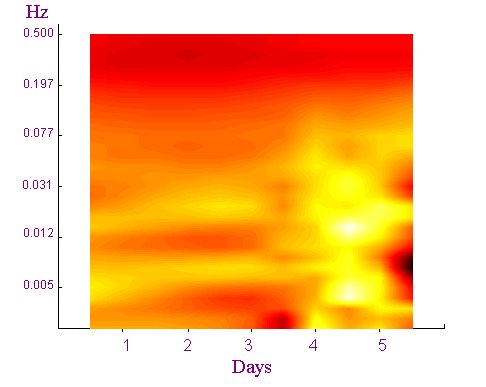 |
| IRF Kiruna |
| IRF Umeå |
| IRF Uppsala |
| IRF Lund |

The objectives of space physics are to study numerous non-linear multivariate processes, often under difficult conditions, unfavourable signal-to-noise ratio. Another difficulty is a vast quantity of information collected in space experiments.
Classical methods of information processing are therefore not fully usable in space research. The present project is aimed to search for new information processing techniques, with a potential for solving typical problems of space physics, and to implement them in actual problems.
Two main areas are covered by the project:
- Analysis of time series
The main area of interest is analysis of multivariate time series, both linear and non-linear. Frequency analysis based on wavelets is implemented on different kinds of data. Methods for diagnostics of chaotic processes, both univariate and multivariate are tested and software for the operational use of these methods is developed.
Work to replace classical signal processing tools, like auto- and crosscorrelation functions with corresponding tools of non-linear statistics, as entropy, mutual information and redundancy, has been started.
Methods of analysis of point processes, such as particle and photon counts, are developed. In particular, photon events from X-ray satellite ROSAT were studied to extract true temporal variations in the photon flux from astronomical sources.
- AI methods in space physics
This part of the project comprises the neural network technology and methods to search for causality. Neural networks were used for modeling of different space processes and for automatic, objective categorization of complex data. Causal modeling technique is used to search for causal relations in complex and fuzzy data.
An important group of tools to study multivariate time series, like multisensor data or time sequences of different kinds of spectra, are decomposition techniques. A linear decomposition technique, based upon the principal component method, was applied to particle energy spectra, FFT frequency spectra and to wavelet spectra. One of the scientific reports describes an application to decomposition of particle energy spectra measured onboard the Viking satellite. The method separates different particle populations and may be used to remove instrumental effects on the observed particle energy spectrum.
In studies of data in the form of point processes, as particle or photon counts, there is an important question, whether the observed process may be fully described by a Poisson distribution (or distributions), or if it is carrying deterministic information. A method, described in two recent scientific reports, has been developed, to extract the true temporal variations of the photon flux from the the photon event history observed by the X-ray satellite ROSAT. Also wavelet technique has been used to study the photon flux variations.

Frequency spectrum (generated using the Morlet wavelet transform) of temporal variations of X-ray emission from an active galactic nucleus (AGN) NGC5548. The graph starts on July 16, 1990 at 23:29:07 UT.
During last 20 years, propagation of infrasonic waves through the upper atmosphere was studied at the Institute. It has been found that introducing the concepts of the non-linear statistics into the signal processing of infraacoustic waves, considerable improvements of the results may be obtained. At present, the angle-of -arrival software was rewritten in such a way that the use of crosscorrelation function was replaced with the entropy based mutual information function.
Another promising technique is filtering of multivariate time series, for example time sequences of spectra, in the principal component space. The present technique does not distort periodic or quasi-periodic phenomena present in the data in the same way as the conventional filtering. The method is described in a recent scientific report.
Neural networks were applied in different problems of space physics. Some of them are:
In complex multivariate processes it is usually difficult, or even impossible, to establish cause-effect relations between observed variables. The physical theory behind the observations may help us to guess about those relations, but until recently it was impossible to present a statistical proof for a given causal model of the process. However, a powerful software, TETRAD, which searches for causal relations in multivariate data, has been developed at Carnegie Mellon University. The present project is aimed to find new applications of causal modeling in space physics. A possibility to use TETRAD to analyze different kinds of spectral data was investigated.
In case of particle energy spectra the method may be used to detect automatically acceleration or deceleration processes.